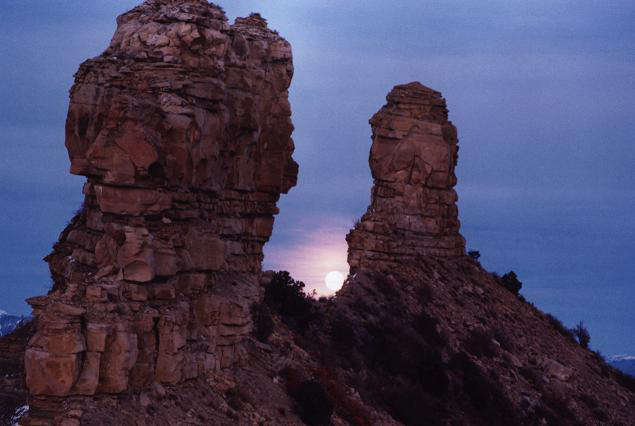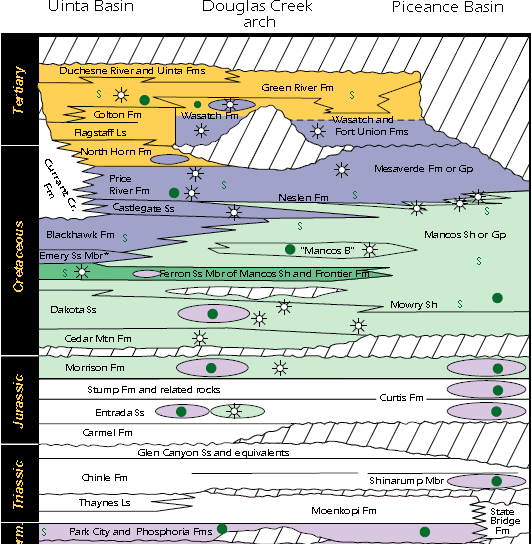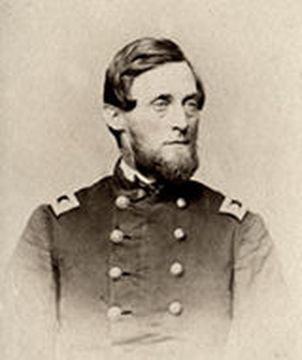|
Chimney Rock (Jackson Butte)
Chimney Rock is an 6,110-foot (1,860 meter) elevation pillar located within the Ute Mountain Tribal Park, in Montezuma County of southwest Colorado. This landmark is situated one mile southeast of the junction of U.S. Route 491 and US 160, and towers 900 feet above the floor of the Mancos River Valley. This geographical feature is also known as Jackson Butte, named for William Henry Jackson (1843–1942), photographer and explorer famous for his images of the American West who visited this area during the Hayden Survey. He was the first to photograph the cliff dwellings in this Mesa Verde region of the Four Corners area. Geology Chimney Rock is located on the Colorado Plateau, and is composed of Cretaceous Point Lookout Sandstone, which is the oldest of the three formations that make up the Mesaverde Group which is common to the Mesa Verde region. The cliff-forming Point Lookout Sandstone overlays a pedestal of softer, slope-forming Mancos Shale.Robert S. Zech, Rich ... [...More Info...] [...Related Items...] OR: [Wikipedia] [Google] [Baidu] |
Chimney Rock National Monument
Chimney Rock National Monument is a U.S. National Monument in San Juan National Forest in southwestern Colorado which includes an archaeological site. This area is located in Archuleta County, Colorado, between Durango and Pagosa Springs, and is managed for archaeological protection, public interpretation, and education. The Chimney Rock Archaeological Site has been listed on the National Register of Historic Places since 1970. U.S. President Barack Obama created Chimney Rock National Monument by proclamation on September 21, 2012 under authority of the Antiquities Act. Geography Chimney Rock National Monument lies on 4,726 acres (19 km2) of San Juan National Forest land surrounded by the Southern Ute Indian Reservation. The Chimney Rock Archeological Area, listed in the National Register of Historic Places in 1970, consists of a central 960 acres. Chimney Rock itself is approximately 315 feet (96 m) tall. Next to Chimney Rock is Companion Rock, which is a popula ... [...More Info...] [...Related Items...] OR: [Wikipedia] [Google] [Baidu] |
Cliff Dwelling
In archaeology, cliff dwellings are dwellings formed by using niches or caves in high cliffs, and sometimes with excavation or additions in the way of masonry. Two special types of cliff dwelling are distinguished by archaeologists: the cliff-house, which is actually built on levels in the cliff, and the cavate, which is dug out, by using natural recesses or openings. Rock-cut architecture generally refers to rather grander temples, but also tombs, cut into living rock, although for example the Ajanta Caves in India, of the 2nd century BCE to 5th century CE, probably housed several hundred Buddhist monks and are cut into a cliff, as are the Mogao Caves in China. Famous cliff dwellings are found around the world. In China, the Guyaju Caves located near Dongmenying, Yanqing District, Beijing are a cave complex of many rock hewn dwellings that form a community. In the United States and Mexico, among the canyons of the southwest, in Arizona, New Mexico, Utah, Colorado, and Chihu ... [...More Info...] [...Related Items...] OR: [Wikipedia] [Google] [Baidu] |
Landforms Of Montezuma County, Colorado
A landform is a natural or anthropogenic land feature on the solid surface of the Earth or other planetary body. Landforms together make up a given terrain, and their arrangement in the landscape is known as topography. Landforms include hills, mountains, canyons, and valleys, as well as shoreline features such as bays, peninsulas, and seas, including submerged features such as mid-ocean ridges, volcanoes, and the great ocean basins. Physical characteristics Landforms are categorized by characteristic physical attributes such as elevation, slope, orientation, stratification, rock exposure and soil type. Gross physical features or landforms include intuitive elements such as berms, mounds, hills, ridges, cliffs, valleys, rivers, peninsulas, volcanoes, and numerous other structural and size-scaled (e.g. ponds vs. lakes, hills vs. mountains) elements including various kinds of inland and oceanic waterbodies and sub-surface features. Mountains, hills, plateaux, and plains are the fou ... [...More Info...] [...Related Items...] OR: [Wikipedia] [Google] [Baidu] |
Chimney Rock (Colorado)
Chimney Rock is an pillar located on the shared boundary of Hinsdale County with Ouray County, in southwest Colorado, United States. It is situated 10.5 miles east of the community of Ridgway, and immediately south of Owl Creek Pass, in the Uncompahgre Wilderness, on land managed by Uncompahgre National Forest. Owl Creek Pass separates Chimney Rock from Cimarron Ridge to the north. It is part of the San Juan Mountains which are a subset of the Rocky Mountains, and is situated west of the Continental Divide. Chimney Rock is the steepest point in Colorado with an average steepness of 61.4 degrees.John Fayhee (2012), ''The Colorado Mountain Companion: A Potpourri of Useful Miscellany from the Highest Parts of the Highest State'', West Margin Press, Topographic relief is significant as the east aspect rises above West Fork Cimarron River in one-half mile. Chimney Rock can be seen from Highway 550 near Ridgway. This feature's name was officially adopted by the United States B ... [...More Info...] [...Related Items...] OR: [Wikipedia] [Google] [Baidu] |
List Of Rock Formations In The United States
The following is a partial list of rock formations in the United States, organized by state. Arizona * Antelope Canyon *Canyon de Chelly National Monument ** Spider Rock * Cathedral Rock, Red Rock State Park, Sedona * Cathedral Rock (Coconino County, Arizona) * Chaistla Butte *Chiricahua National Monument **Big Balanced Rock **Duck on a Rock **Mushroom Rock **Natural Bridge **Organ Pipe **Pinnacle Balanced Rock **Punch and Judy **Sea Captain * Church Rock *Comb Ridge *Coyote Buttes ** The Wave * Grand Canyon **Angels Gate ** Angels Window **Apollo Temple ** Brahma Temple **Buddha Temple **Cheops Pyramid **Chuar Butte **Coronado Butte **Deva Temple **Dox Castle ** Explorers Monument ** Gunther Castle ** Holy Grail Temple ** Horseshoe Mesa ** Manu Temple **Marsh Butte ** Mount Hayden ** Mount Sinyella ** O'Neill Butte **Shiva Temple ** Sinking Ship ** Tower of Ra ** Tower of Set **Vishnu Temple ** Wotans Throne **Zoroaster Temple **Numerous other named buttes, mesas, and "t ... [...More Info...] [...Related Items...] OR: [Wikipedia] [Google] [Baidu] |
Mancos River
The Mancos River, formerly also El Rio de San Lazaro, is an U.S. Geological Survey. National Hydrography Dataset high-resolution flowline dataThe National Map, accessed March 21, 2011 northeast tributary of the San Juan River. It flows from the confluence of West Mancos River and East Mancos River near Mancos, Colorado and joins the San Juan near Four Corners Monument in New Mexico. The river was named after an incident during which a horse rider hurt his hand while crossing, the word ''Mancos'' being derived from Spanish meaning "one-armed". See also *List of rivers of Colorado *List of rivers of New Mexico A ''list'' is any set of items in a row. List or lists may also refer to: People * List (surname) Organizations * List College, an undergraduate division of the Jewish Theological Seminary of America * SC Germania List, German rugby union ... * List of tributaries of the Colorado River References Rivers of Colorado Rivers of New Mexico Tributaries of the ... [...More Info...] [...Related Items...] OR: [Wikipedia] [Google] [Baidu] |
Surface Runoff
Surface runoff (also known as overland flow) is the flow of water occurring on the ground surface when excess rainwater, stormwater, meltwater, or other sources, can no longer sufficiently rapidly infiltrate in the soil. This can occur when the soil is saturated by water to its full capacity, and the rain arrives more quickly than the soil can absorb it. Surface runoff often occurs because impervious areas (such as roofs and pavement) do not allow water to soak into the ground. Furthermore, runoff can occur either through natural or man-made processes. Surface runoff is a major component of the water cycle. It is the primary agent of soil erosion by water. The land area producing runoff that drains to a common point is called a drainage basin. Runoff that occurs on the ground surface before reaching a channel can be a nonpoint source of pollution, as it can carry man-made contaminants or natural forms of pollution (such as rotting leaves). Man-made contaminants in runoff i ... [...More Info...] [...Related Items...] OR: [Wikipedia] [Google] [Baidu] |
Mancos Shale
The Mancos Shale or Mancos Group is a Late Cretaceous (Upper Cretaceous) geologic formation of the Western United States. The Mancos Shale was first described by Cross and Purington in 1899 and was named for exposures near the town of Mancos, Colorado. Geology The unit is dominated by mudrock that accumulated in offshore and marine environments of the Cretaceous North American Inland Sea. The Mancos was deposited during the Cenomanian (locally Albian) through Campanian ages, approximately from 95 million years ago ( Ma) to 80 Ma. Stratigraphically the Mancos Shale fills the interval between the Dakota and the Mesaverde Group. The lower marine Mancos Shale conformably intertongues with terrestrial sandstones and mudstones of the Dakota and in its upper part grades into and intertongues with the Mesaverde Group. The shale tongues typically have sharp basal contacts and gradational upper contacts. Whereas in the plains east of the Rocky Mountains certain mappable marine sh ... [...More Info...] [...Related Items...] OR: [Wikipedia] [Google] [Baidu] |
Mesaverde Group
The Mesaverde Group is a Late Cretaceous stratigraphic group found in areas of Colorado, New Mexico, Utah, and Wyoming, in the Western United States. History The Mesaverde Formation was first described by W.H.Holmes in 1877 during the Hayden Survey. Holmes described the formation in the northern San Juan Basin as consisting of three units, which were a "Lower Escarpment" consisting of 40 m of ledge- and cliff-forming massive sandstone; a "Middle Coal Group" consisting of up to 300 m of thick slope-forming sandstone, shale, marl, and lignite; and an "Upper Escarpment" consisting of 60 m of ledge- and cliff-forming sandstone. A.J. Collier redesignated these units in 1919 as the Point Lookout Sandstone, the Menefee Formation, and the Cliff House Sandstone, and raised the Mesaverde Formation to group rank. The group was later traced to the greater Green River Basin, the Uintah and Piceance Basins, the Bighorn Basin, the Front Range, the Zuni Basin, the Wasatch Plateau, Win ... [...More Info...] [...Related Items...] OR: [Wikipedia] [Google] [Baidu] |
Four Corners
The Four Corners is a region of the Southwestern United States consisting of the southwestern corner of Colorado, southeastern corner of Utah, northeastern corner of Arizona, and northwestern corner of New Mexico. The Four Corners area is named after the quadripoint at the intersection of approximately 37° north latitude with 109° 03' west longitude, where the boundaries of the four states meet, and are marked by the Four Corners Monument. It is the only location in the United States where four states meet. Most of the Four Corners region belongs to semi-autonomous Native American nations, the largest of which is the Navajo Nation, followed by Hopi, Ute, and Zuni tribal reserves and nations. The Four Corners region is part of a larger region known as the Colorado Plateau and is mostly rural, rugged, and arid. In addition to the monument, commonly visited areas within Four Corners include Monument Valley, Mesa Verde National Park, Chaco Canyon, Canyons of the Ancie ... [...More Info...] [...Related Items...] OR: [Wikipedia] [Google] [Baidu] |
Mesa Verde Region
The Mesa Verde Region is a portion of the Colorado Plateau in the United States that extends through parts of New Mexico, Colorado and Utah. It is bounded by the San Juan River to the south, the Piedra River to the east, the San Juan Mountains to the north and the Colorado River to the west. The Crow Canyon Archaeological Center near Cortez, Colorado, in the heart of the Mesa Verde, has been conducting research in the region since 1982. Although the Mesa Verde National Park contains the largest and best known ruins of the Pueblo peoples, there are many other community centers in the central Mesa Verde region dating to the period between 1050 and 1290 AD. This is a huge area covering over . Over 130 centers containing fifty or more residential structures have been identified in the central region, many of which have yet to be examined in any detail. A small portion of the Mesa Verde to the southeast of Cortez, Colorado contains the Mesa Verde National Park, which protects almos ... [...More Info...] [...Related Items...] OR: [Wikipedia] [Google] [Baidu] |
Ferdinand Vandeveer Hayden
Ferdinand Vandeveer Hayden (September 7, 1829 – December 22, 1887) was an American geologist noted for his pioneering surveying expeditions of the Rocky Mountains in the late 19th century. He was also a physician who served with the Union Army during the Civil War. Early life Ferdinand Hayden was born in Westfield, Massachusetts. As a young boy he was fascinated with all nature and wildlife, which led him into the field of medicine. He worked in Cleveland under Jared Potter Kirtland and thereafter in Albany, NY, where he worked under James Hall, of the ''Geological Survey of New York''. He graduated from Oberlin College in 1850 and from the Albany Medical College in 1853, where he attracted the notice of Professor James Hall, state geologist of New York, through whose influence he was induced to join in an exploration of Nebraska Territory, with Fielding B. Meek to study geology and collect fossils. Hall sent him on his first geological venture in the summer of 1853. Be ... [...More Info...] [...Related Items...] OR: [Wikipedia] [Google] [Baidu] |

%2C_Arizona.jpg)
.jpg)






